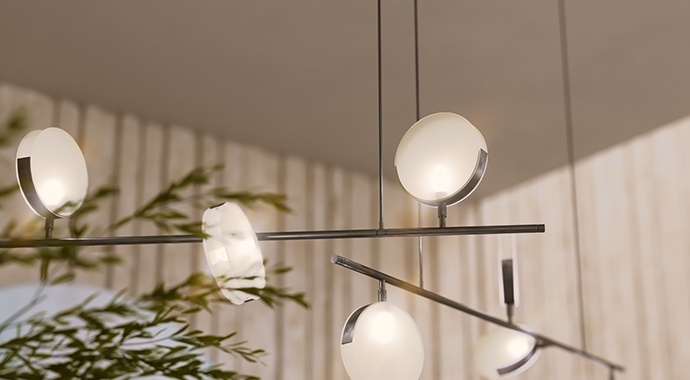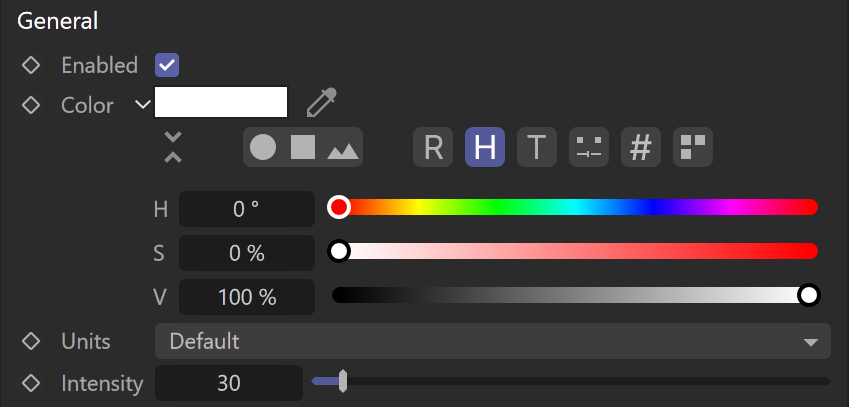This page provides information about the Mesh Light in V-Ray for Cinema 4D.
Overview
The Mesh Light can create light sources that have volume and shape without the need to use self-illuminated objects and global illumination.
If the Mesh Light is close to other surfaces in the scene, it is best to use it with GI enabled so V-Ray can use combined direct and GI sampling of the mesh light. Without GI, the light might produce noisy results for surfaces that are very close to it.
UI Path: ||V-Ray|| > V-Ray Lights > Mesh Light
Create Mesh Light
To turn a selected object into a Mesh Light, create a Mesh Light first from the V-Ray menu. Then drag and drop the object to the Mesh Light item in the Objects tab, making it a child of the Mesh Light.
Now the object has Mesh Light properties and you can control its settings from the parameters listed below.
General
Enabled – Determines whether or not the Mesh Light emits light in the scene.
Color – Specifies the color of the light. When using photometric units, this color is normalized so that only the color hue is used, whereas the light intensity is determined by the Intensity.
Units – Using correct units is essential when you are working with the V-Ray Physical Camera. Note that when changing these units, the Intensity multiplier value is not converted to match the lighting and uses the same amount for all different units. The possible values are:
Default – The color and multiplier directly determine the visible color of the light without any conversion. The light surface appears with the given color in the final image when seen directly by the camera (assuming there is no color mapping involved).
Lumens – Total emitted visible light power measured in lumens. When this setting is used, the intensity of the light does not depend on its size. A typical 100W electric bulb emits about 1500 lumens of light.
Lm/m/m/sr – Visible light surface power measured in lumens per square meter per steradian. When this setting is used, the intensity of the light depends on its size.
Watts – Total emitted visible light power measured in watts. When using this setting, the intensity of the light does not depend on its size. Keep in mind that this is not the same as the electric power consumed by the light source. A typical 100W light bulb only emits between 2 and 3 watts as visible light.
W/m/m/sr – Visible light surface power measured in watts per square meter per steradian. When this setting is used, the intensity of the light depends on its size.
Intensity – A multiplier for the light Color; this is also the light intensity in the units chosen by the Units parameter.
Options
Invisible – Controls whether the shape of the V-Ray Mesh Light source is visible in the render result. When this option is turned off, the source is rendered in the current light color. Otherwise, it is not visible in the scene. Note that this option only affects the visibility of the light when seen directly by the camera or through refractions. The visibility of the light with respect to reflections is controlled by the Affect specular and Affect Reflections options.
Occlude Other Lights – Controls the behavior of the light when Invisible is enabled in relation to other light sources. When enabled, the light blocks the lighting from other lights as if it's visible. Also, in reflections, the light behaves as it's visible and occludes other lights. When disabled, the light is transparent for other lights and does not occlude them. This option doesn't affect visible lights (as they always occlude other lights) and dome lights (which are always additive).
Double Sided – Controls whether light is emitted from both sides of each face.
Affect Diffuse – Determines whether the light affects the diffuse properties of the materials.
Affect Specular – Determines whether the light affects the specular properties of the materials. This means glossy reflections.
Affect Reflections – Determines whether the light appears in reflections of materials. This means both perfect and glossy reflections.
Affect Atmospherics – When enabled, the light influences the atmospheric effects in the scene.
Diffuse Contribution – A multiplier for the effect of the light on the diffuse.
Specular Contribution – A multiplier for the effect of the light on the specular.
Atmospherics Contribution – Determines the amount of influence the light has on the atmospheric effects, such as Environment Fog or V-Ray Volume Grid.
Ignore Lights Normals – When this option is disabled, more light is emitted in the direction of the source surface normal.
LPE Label – Allows a label to be assigned, which can be used to reference the light in a Light Path Expression. This is especially useful when working with the Light Select render element to evaluate custom light contribution in the scene.
Shadows
Shadows – When enabled (the default), the light casts shadows. Turn this option off to disable shadow casting for the current light.
Shadow Color – Controls the color of shadows for this light. Note that anything different from black is not physically correct. This option is inactive when using the V-Ray GPU engine.
Shadow Bias – Moves the shadow toward or away from the shadow-casting object. Higher values move the shadow toward the object, while lower values move it away. If this value is too extreme, shadows can "leak" through places they shouldn't or "detach" from an object. Other effects from extreme values include Moire patterns, out-of-place dark areas on surfaces, and shadows not appearing at all in the render.
Photon Emission
Caustics Subdivs – Used by V-Ray when calculating Caustics. Lower values mean more noisy results but will render faster. Higher values produce smoother results but take more time.
Caustics Multiplier – A multiplier for the generated caustics by the selected light.
Sampling
Cut-off Threshold – Specifies a threshold for the light intensity below which the light is not computed. This can be useful in scenes with many lights, where you want to limit the effect of the lights to some distance around them. Larger values cut away more from the light; lower values make the light range larger. If you specify 0.0, the light is calculated for all surfaces. This parameter is not available when the renderer is set to V-Ray GPU.
Decay
The Decay parameters determine how the light fades in and out. The Near Decay determines how light fades in. The light isn't at its maximum value at its source but instead gradually increases until it reaches the Near end. The Far Decay determines how light fades out. The light isn't at its maximum value at its end but instead gradually decreases after the Far start.
The Decay option is useful for creating hotspots or controlling the length of a "God Rays" effect created with Environment Fog.
Near Decay On – Toggles near decay on and off.
Near Decay Start – Determines where the fade in starts. Anything before this point is rendered dark.
Near Decay End – Determines where the fade in ends. After this threshold, the light is at its full value.
Far Decay On – Toggles far decay on and off.
Far Decay Start – Determines where the fade off starts.
Far Decay End – Determines where the light reaches a value of 0, i.e. completely fades off. See the Far Decay End example for more.
Example: Far Decay End
Decay = Off
Far Decay End = 1000
Far Decay End = 250
Texture
Use Texture – Allows the light to use a texture for its surface. If there are surfaces that are close to a texture-mapped light, it is best to have GI enabled. This allows V-Ray to use combined direct and indirect sampling for the light, reducing the noise for surfaces close to the light.
Tex – Specifies the texture to use. Note: If an RGBA texture file (a file that contains an alpha channel) is used, the file's alpha output must be connected to the Texture Alpha attribute to utilize the alpha channel on the light.
Texture Cache Resolution – Specifies the resolution at which the texture is cached.
Cache Texture – When enabled, V-Ray samples the texture and produces a lower-resolution version to be used for the lighting. This greatly speeds up the rendering of mesh lights with textures.
Project
Project is used to create a list of objects that can be excluded (or included) from the light's effects, such as illumination or shadow casting.
Mode – Specifies whether the objects in the list are considered included or excluded from the light's effects.
Objects – Creates a list of objects to be excluded or included. When an object is added to the list, the icons appear, which determine how the light affects the object. The icon controls whether the emitted light affects the object. The icon controls whether the shadows caused by the light affect the object. The determines whether the object's children are affected.















